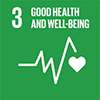Adults with cerebral palsy are about twice as likely to develop cardiovascular and chronic respiratory disease compared to adults without cerebral palsy according to a study led by RCSI,
The study, led by Dr Jennifer Ryan at RCSI with Brunel University London, compared 1,700 adults with cerebral palsy and 5,000 adults without cerebral palsy to identify how many developed non-infectious diseases, such as asthma or stroke. The research was published in Neurology.
Patients with cerebral palsy were overall 75% more likely to have a non-communicable disease. After adjusting for other variables, the study also found that adults with cerebral palsy were around twice as likely to develop cardiovascular and chronic respiratory disease, such as asthma, but not more likely to develop diabetes or cancer.
Adults with cerebral palsy were specifically 2.6 times more likely to develop heart failure, 5.5 times more likely to have a stroke, 2.2 times more likely to develop asthma, 1.6 times more likely to develop hypertension and 2.3 times more likely to develop ischaemic heart disease.
Globally, approximately 17 million people have cerebral palsy. Although cerebral palsy was historically considered a paediatric condition, the majority of children with cerebral palsy now survive into adulthood and many adults with cerebral palsy have a near-normal life expectancy. Cerebral palsy is not a progressive condition. However, at least a quarter of young adults report that their ability to walk gets worse, which may contribute to the development of chronic health conditions.
The study was funded by the Brunel University London Research Catalyst Fund, and it involved collaborators from Brunel University London, University of Michigan-Medicine, London School of Hygiene and Tropical Medicine, Aberdeen Royal Infirmary, Hospital Clinico San Carlos, University of Surrey and Queen Mary University London.
RCSI is committed to achieving a better and more sustainable future through the UN Sustainable Development Goals.

